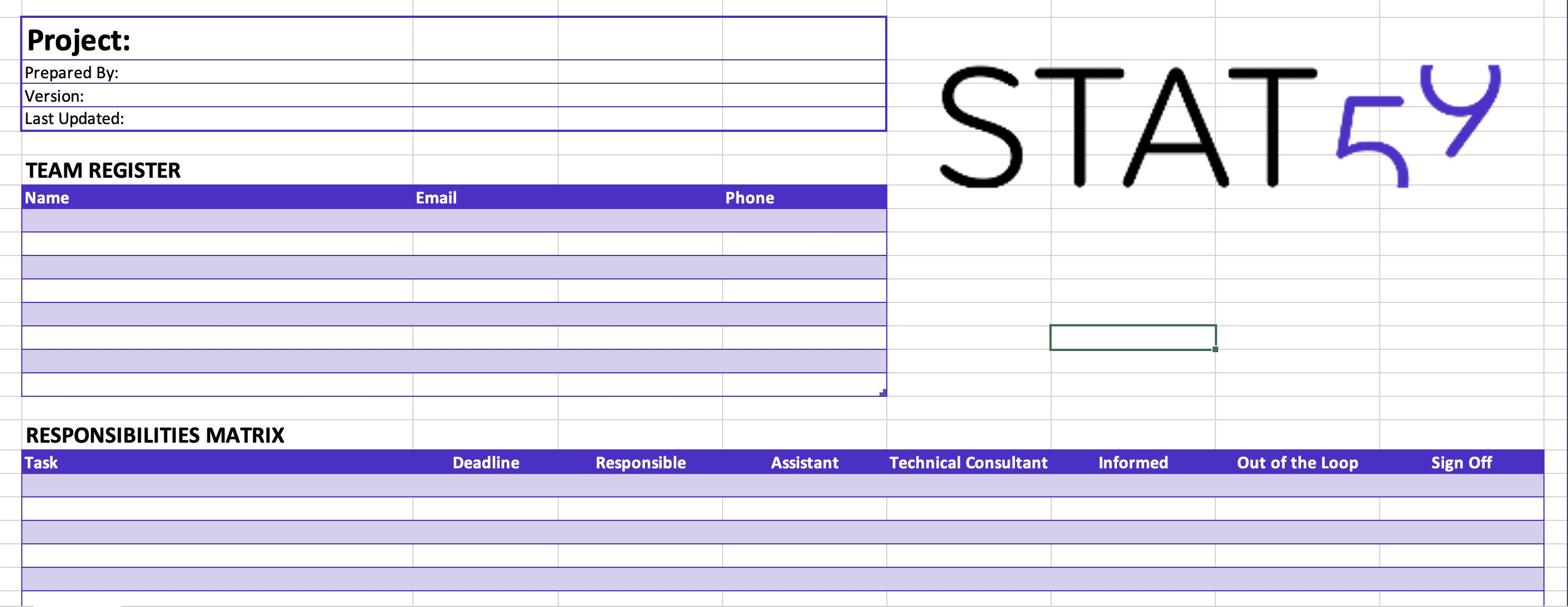RATIOS: The Responsibility Assignment Matrix for Research Projects
July 27, 2023, 4:47 a.m.

Research projects often feel like liquids, where the team expands to fill the available space. Sometimes having a large team to work with can be a great advantage. However, large teams require an additional level of effort to manage.
We are big fans of the Amazon Two-Pizza Rule. This rule states that an internal team should be small enough that it can be fed with two pizzas. This is usually around five to nine people. These teams are agile and easy to manage. They usually don’t require an organizational chart, terms of reference, or a complicated project charter. They exist as a type of simple autonomous collective.
Not all teams can be this small. Sometimes projects require larger teams, and they need more concrete management strategies. In teams larger than nine people, the adage “failing to plan is planning to fail” seems to come up often. Larger teams MUST have a way to divide and assign tasks to be successful. Clarity of who is doing what task and when it is due is fundamental to project success.
The Responsibility Assignment Matrix
Six-Sigma training teaches about responsibility assignment matrices. These are a relatively simple matrix or spreadsheet that maps people to tasks. A project is divided into smaller tasks, and for each task, each person is given a certain level of responsibility. Generally, they are organized as a table where each row is a task, and the columns show who is working on the task.
The most common Six-Sigma tool is the RACI matrix. In this matrix, team members are assigned to a task as either Responsible, Accountable, Consulted, or Informed. We have used this matrix on many projects, and it often works very well. However, when working on a large research project recently, we have found a few key weaknesses in the RACI matrix. For instance, the terms Responsible and Accountable were often confused. Since the project leader is ultimately accountable for everything, did they need to be named in each row? It was also unclear if a person could be in multiple columns for the same task.
The RATIOS Matrix
The RATIOS matrix is an updated version of the Responsibility Assignment Matrix that we have developed that is focussed specifically on large research projects. It uses the headings Responsible, Assistant, Technical Consultant, Informed, Out of the Loop, and Sign Off to classify each person’s role in the task. We find these terms to be clearer for researchers. In addition, since the terms are mutually exclusive, each person is assigned to only one role.

Responsible
These are the people who will do the task. They are the workers. At least one person must be assigned to this role, although this could be several members within the larger team.
Assistant
These are the assistants to those responsible. They help with the task, but are not responsible for its completion. This could include, for example, research assistants, graphic designers, or administrative support.
Technical Consultants
Technical consultants help with a specific component of the task by providing technical data, interpretation, support, and advice.
Informed
Those in the Informed group will be told about the results of the task, but do not have input into the content. For example, if another task in the matrix (Task B) depends on the results of this task (Task A), then the Responsible member for Task B could be listed as Informed under Task A.
Out of the Loop
Sometimes it is useful to specifically pinpoint who is not part of the task. Those in the Out of the Loop group are not involved. They do not need to approve of the task, nor do they need to be specifically consulted. They can be informed of progress, but it is not necessary for the success of the task nor of the project.
Sign Off
Sometimes (in larger organizations, especially) someone needs to give the final sign-off or approval of a task. Use this role when someone is not involved in doing the task, but must give final sign off once the task is complete.
How to Use the RATIOS Matrix
How do you use this thing?
- Decide where you will host the matrix. The tasks and the responsibilities will almost certainly change as the project progresses. Ideally, the up-to-date matrix should be always available to the team: such as an online document or embedded into a project management software. Whatever you choose, it is imperative that the matrix be accessible to all team members at any time (at least in a read-only format).
-
Set up the table with the following column headings or download the RATIOS Excel Tool:
- Task
- Deadline
- Responsible
- Assistant
- Technical Consultant
- Informed
- Out of the loop
- Sign off
- Next, divide the project into manageable tasks. Describe each task in the “Task” column.
- Give a deadline for the task. Be conscious of any potential precedent or dependent tasks when setting deadlines.
- Assign at least one person to the RESPONSIBLE column. Put their name in the column.
- Assign additional team members to the other columns in the row. Consult the definitions above if you are unsure which column is best. Remember, for each row, a person should have their name in only one column.
- Update the table with additional tasks as they arise.
- Update the roles for each task as they change.
One of the biggest pitfalls of a responsibility matrix is lack of communication. Often the matrix is created in isolation by the team leader, poorly communicated to the project team, and never reviewed and updated as the project progresses. The plan must be developed cooperatively with the team and should be used as a roadmap to project success.
Keeping a large project organized and on time requires all the team members to be honest about their skill set and their available time. If team members do not feel they can complete the task as described by the due date, they should voice their concerns at the outset and an alternate plan should be developed.
Responsibility assignment matrices are designed to maximize the efficiency of the team. Just as important as who is assigned to a task is who is NOT assigned to a task. The most common error we see among high-performing innovative teams is that each team member wants to be involved in every task. Leaders should encourage team members to instead concentrate their efforts on fewer tasks. Each row (task) in the matrix should have only a few key team members working on it. This will alleviate the problem of “If everyone is doing it, no one is doing it.”

Be prepared to change or move the team members for each task as needed: if new team members are added, if members leave the team, or if optimization is necessary. Team members who are assigned to a task but cannot complete it should be encouraged to notify the team leader, and the matrix updated to keep the task on time.
A Responsibilities Matrix is all about clarity. It ensures that the team knows who is working on what, when they are working on it, and how they can help. It is not meant to suppress creativity or involvement, and used properly it will create an environment of support and success.
If you are ready to get started on your own RATIOS matrix, and take the lead in research project management, be sure to download the STAT59 RATIOS Excel Template Tool and get the head-start on your own project. And, if you like the tool, please share the blog post on your own social media.
This blog post, the RATIOS responsibility matrix, and the RATIOS tool were co-developed by Cameron Franchuk and Jeffrey Franc.
Are You Ready to Increase Your Research Quality and Impact Factor?
Sign up for our mailing list and you will get monthly email updates and special offers.
